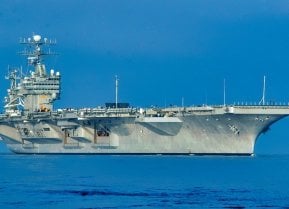U.S. Navy Aircraft Carrier USS George Washington: A Troubled History?
Indeed, the USS George Washington is a floating city, well equipped to execute an aircraft carrier’s primary purpose: projecting air power abroad.
Meet the USS George Washington: George Washington looms as a nearly-mythical figure in American history. Commander-in-Chief of the Continental Army during the American Revolutionary War. Founding Father. First-ever President of the United States.
George Washington may have singular recognition in American history. Fittingly, the Washington name adorns the American capital, the state of Washington, countless schools and streets – and one Nimitz-class aircraft carrier.
The USS George Washington
Designated CVN-73, the USS George Washington is the fourth US Navy ship named after George Washington, the first nuclear-powered carrier to bear the name.
USS George Washington is the sixth-carrier in the Nimitz-class and was first laid down in 1986.
Christened by Barbara Bush (while her husband George watched) in 1990 and finally commissioned in 1992, the George Washington is a 1,092-foot behemoth with 104,200 tons of displacement and a 252 foot beam.
For propulsion, the George Washington relies on two Westinghouse A4W nuclear reactors, four steam turbines, four shafts, and four 5-bladed propellers (measuring 66,220 pounds each) – all of which can generate 260,000 horsepower and a top speed in excess of 30 knots.
The George Washington is a floating city, capable of accommodating 6,250 crewmembers.
With four distilling units, the George Washington can provide its several thousand crew members with 400,000 gallons of potable water a day. To feed the crew, over 18,000 meals are served per day. And to house the crew, the George Washington is outfitted with 2,500 compartments, which require 2,520 refrigeration tons of air conditioning capacity (roughly the equivalent to cool 2,000 homes).
Indeed, the USS George Washington is a floating city, well equipped to execute an aircraft carrier’s primary purpose: projecting air power abroad. To that end, the Georg Washington is equipped with a variety of weapons systems.
Currently, the George Washington features one 20 mm Phalanx CIWS mount, one Sea Sparrow SAM launcher, and two RIM-116 Rolling Airframe Missile launchers.
Yet, like all aircraft carriers, the George Washington’s most impressive offensive feature is her complement of aircraft. The George Washington can carry up to 90 fixed wing and rotary wing aircraft. Most notably, the George Washington carries the F-35 Lightning II and the F/A-18 Super Hornet, fifth- and fourth-plus-generation fighters, respectively.
But despite the impressive specifications of the USS George Washington, the ship’s tenure has not been without its problems.
Fire at Sea
In May 2008, a fire broke out aboard the George Washington, while the ship was en route to Japan, off the Pacific coast of South America. According to the Navy, the incident was “serious,” injuring 37 sailors.
The fire is reported to have originated in the George Washington’s air-conditioning and refrigeration space and an auxiliary boiler room. The fire is understood to have spread through the ship’s cableway and ventilation ducting. Eventually, the fire spread to eight decks and 80 compartments. In effected areas of the ship, the fire resulted in extreme temperatures. Miles and miles of electrical and fiber-optic cable were destroyed.
Twelve hours were needed for the crew to contain and extinguish the flame, marking the biggest non-combat fires aboard a US Navy vessel since the USS Forrestal fire in 1967.
Seeking repairs, the George Washington diverted to NAS North Island in San Diego where the Navy reported that the fire damage was more serious than initially understood. Repairs took several months and cost US taxpayers $70 million.
Later, a Navy investigation uncovered that the fire had been “entirely preventable.” The cause? Unauthorized smoking in a room where 115 gallons of flammable refrigerant compressor oil was being stored improperly.
Admiral Robert F. Willard, the commander of the US Pacific Fleet, noted afterward that “It is apparent from this extensive study that there were numerous processes and procedures related to fire prevention and readiness and training that were not properly functioning. The extent of damage could have been reduced had numerous longstanding firefighting and firefighting management deficiencies been corrected.”
Problems with the Crew
Over a nine-month period between 2021 and 2022, while the George Washington was docked for an extensive overhaul, ten sailors committed suicide.
While servicemembers have a higher suicide rate than the general population, the ten suicides aboard one boat, over a relatively short period of time, was startling. The Navy conducted an investigation, finding that the crew described life aboard the George Washington like “living at a construction site.”
Many sailors said they suffered from lack of sleep and preferred sleeping in their cars to sleeping on the George Washington.
Compounding the situation further, many of the crew, who had been trained for meaningful shipboard duties, had been relegated to maintenance and cleaning duties.
Regardless, once the George Washington’s overhaul is ready, the ship will be re-deployed next year. The George Washington is expected to sail to Japan, where she will be forward deployed.
About the Author
Harrison Kass is a prolific defense writer with over 1,000 articles published. An attorney, pilot, guitarist, and minor pro hockey player, Harrison joined the US Air Force as a Pilot Trainee but was medically discharged. Harrison holds a BA from Lake Forest College, a JD from the University of Oregon, and an MA from New York University. Harrison listens to Dokken.
All images are Creative Commons.


